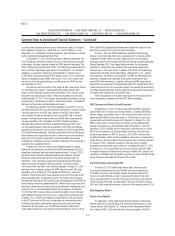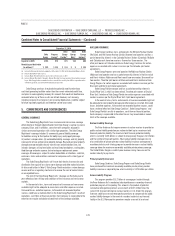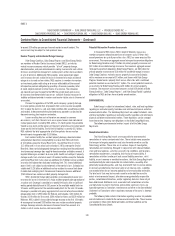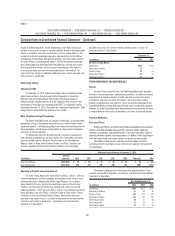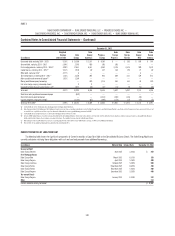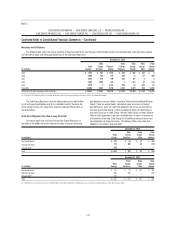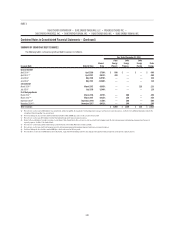Duke Energy 2014 Annual Report Download - page 151
Download and view the complete annual report
Please find page 151 of the 2014 Duke Energy annual report below. You can navigate through the pages in the report by either clicking on the pages listed below, or by using the keyword search tool below to find specific information within the annual report.
131
PART II
DUKE ENERGY CORPORATION • DUKE ENERGY CAROLINAS, LLC • PROGRESS ENERGY, INC. •
DUKE ENERGY PROGRESS, INC. • DUKE ENERGY FLORIDA, INC. • DUKE ENERGY OHIO, INC. • DUKE ENERGY INDIANA, INC.
Combined Notes to Consolidated Financial Statements – (Continued)
(in millions)
Duke
Energy
Duke
Energy
Carolinas
Progress
Energy
Duke
Energy
Progress
Duke
Energy
Florida
Duke
Energy
Ohio
Duke
Energy
Indiana
Balance at December 31, 2011 61 12 23 11 12 28 9
Provisions / adjustments 39 1 19 5 14 5 3
Cash reductions (25) (1) (9) (2) (7) (18) (4)
Balance at December 31, 2012 75 12 33 14 19 15 8
Provisions / adjustments 26 — 4 (1) 5 20 1
Cash reductions (22) (1) (10) (5) (5) (8) (2)
Balance at December 31, 2013 79 11 27 8 19 27 7
Provisions / adjustments 32 (1) 1 4 (3) 28 4
Cash reductions (14) — (11) (7) (4) (1) (1)
Balance at December 31, 2014 97 10 17 5 12 54 10
Additional losses in excess of recorded reserves that could be incurred for
the stages of investigation, remediation and monitoring for environmental sites
that have been evaluated at this time are presented in the table below.
(in millions)
Duke Energy $ 89
Duke Energy Carolinas 25
Progress Energy 15
Duke Energy Progress 1
Duke Energy Florida 14
Duke Energy Ohio 42
Duke Energy Indiana 7
North Carolina and South Carolina Ash Basins
On February 2, 2014, a break in a 48-inch stormwater pipe beneath an ash
basin at Duke Energy Carolinas’ retired Dan River steam station caused a release
of ash basin water and ash into the Dan River. On February 8, 2014, a permanent
plug was installed in the 48-inch stormwater pipe, stopping the release of
materials into the river. Duke Energy Carolinas estimates 30,000 to 39,000 tons
of ash and 24 million to 27 million gallons of basin water were released into
the river during the incident. Duke Energy Carolinas incurred approximately
$24 million of repairs and remediation expense related to this incident during
the year ended December 31, 2014. These amounts are recorded in Operations,
maintenance and other on the Consolidated Statements of Operations and
Comprehensive Income. Duke Energy Carolinas will not seek recovery of these
costs from customers. In July, Duke Energy completed remediation work identifi ed
by the EPA and continues to cooperate with the EPA’s civil enforcement process.
See the “Litigation” section below for additional information on litigation,
investigations, and enforcement actions related to ash basins. Other costs
related to the Dan River release, including pending or future state or federal
civil enforcement proceedings, future regulatory directives, natural resources
damages, additional pending litigation, future claims or litigation, and long-term
environmental impact costs cannot be reasonably estimated at this time.
On September 20, 2014, the North Carolina Coal Ash Management Act
of 2014 (Coal Ash Act) became law. The Coal Ash Act (i) establishes a Coal
Ash Management Commission to oversee handling of coal ash within the state;
(ii) prohibits construction of new and expansion of existing ash impoundments
and use of existing impoundments at retired facilities, effective October 1,
2014; (iii) requires closure of ash impoundments at Duke Energy Progress’
Asheville and Sutton stations and Duke Energy Carolinas’ Riverbend and
Dan River stations no later than August 1, 2019; (iv) requires dry disposal
of fl y ash at active plants not retired by December 31, 2018; (v) requires dry
disposal of bottom ash at active plants by December 31, 2019, or retirement
of active plants; (vi) requires all remaining ash impoundments in North
Carolina to be categorized as high-risk, intermediate-risk, or low-risk no later
than December 31, 2015 by the North Carolina Department of Environment
and Natural Resources (DENR) with the method of closure and timing to
be based upon the assigned risk, with closure no later than December 31,
2029; (vii) establishes requirements to deal with groundwater and surface
water impacts from impoundments and (viii) enhances the level of regulation
for structural fi lls utilizing coal ash. The Coal Ash Act includes a variance
procedure for compliance deadlines and modifi cation of requirements regarding
structural fi lls and compliance boundaries. Provisions of the Coal Ash Act
prohibit cost recovery for unlawful discharge of ash basin waters occurring after
January 1, 2014. The Coal Ash Act included a moratorium for any NCUC ordered
rate changes to effectuate the legislation, which ended January 15, 2015. The
Coal Ash Act leaves the decision on cost recovery determinations related to
closure of coal combustion residuals surface impoundments (ash basins or
impoundments) to the normal ratemaking processes before utility regulatory
commissions. In November 2014, Duke Energy submitted to DENR site specifi c
coal ash excavation plans for the four high priority stations required to be closed
no later than August 1, 2019. These plans and all associated permits must be
approved by DENR before any excavation work can begin.
In September 2014, Duke Energy Carolinas executed a consent agreement
with the South Carolina Department of Health and Environmental Control
(SCDHEC) requiring the excavation of an inactive ash basin and ash fi ll area at
the W.S. Lee Steam Station. As part of this agreement, in December 2014, Duke
Energy Carolinas fi led an ash removal plan and schedule with SCDHEC.
Duke Energy Carolinas and Duke Energy Progress recorded asset
retirement obligations at December 31, 2014 based upon the legal obligation for
closure of coal ash basins and the disposal of related ash as a result of the Coal
Ash Act and the agreement with SCDHEC. Refer to Note 9 for further discussion
of the asset retirement obligations recorded at December 31, 2014.
Coal Combustion Residuals
On December 19, 2014, the EPA signed the fi rst federal regulation for the
disposal of coal combustion residuals (CCR) from power plants. The federal
regulation classifi es CCR as nonhazardous waste under the Resource Conservation
and Recovery Act and applies to all new and existing landfi lls, new and existing
surface impoundments, structural fi lls and CCR piles. The rule establishes
requirements regarding landfi ll design, structural integrity design and assessment








